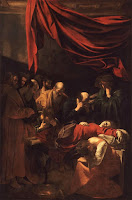Presence of David and Goliath (Rome)
 |
| David with the Head of Goliath (1610) by Caravaggio |
David with the Head of Goliath Analysis
 |
| Caravaggio's Self Portrait as Severed Head of Goliath |
 |
| David the Young Shepherd |
 |
| H-AS OS (humility kills pride) on David's Sword |
 |
| David Slaying Goliath (1520) by Ugo da Carpi |
 |
| David Slaying Goliath (1616) by Peter Paul Rubens |
Michelangelo Merisi da Caravaggio in Baroque Period
 |
| Simone Peterzano Self-Portrait (1589) |
 |
| Titian Self-Portrait (1567) |
 |
| Death of the Virgin (1606) by Caravaggio |
 |
| The Seven Works of Mercy (1607) by Caravaggio |
 |
| The Martyrdom of Saint Ursula (1610) by Caravaggio |
 |
| Bacchus (1598) by Caravaggio |
 |
| Narcissus (1597-1599) by Caravaggio |
Every Painter Paints Himself
 |
| Medusa (1597) by Caravaggio |
 |
| Self-Portrait as the Allegory of Painting (1638-1639) by Artemisia Gentileschi |
 |
| Picasso Self-Portrait (1901) |
 |
| Vincent van Gogh Self-Portrait (1887) |
Usage of David and Goliath within Underdog Situations
David and Goliath (Caravaggio, Rome)
 Reviewed by Articonog
on
May 21, 2020
Rating:
Reviewed by Articonog
on
May 21, 2020
Rating:
 Reviewed by Articonog
on
May 21, 2020
Rating:
Reviewed by Articonog
on
May 21, 2020
Rating:




No comments: